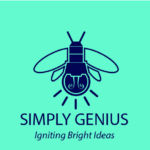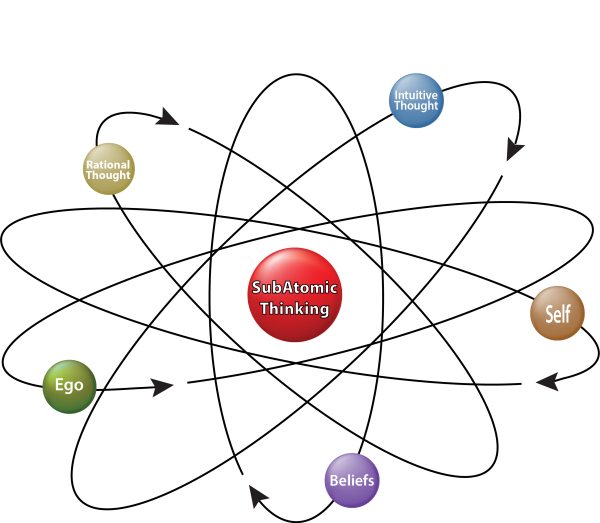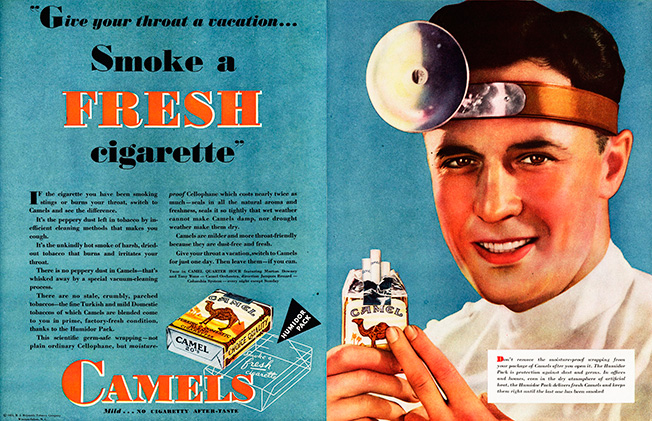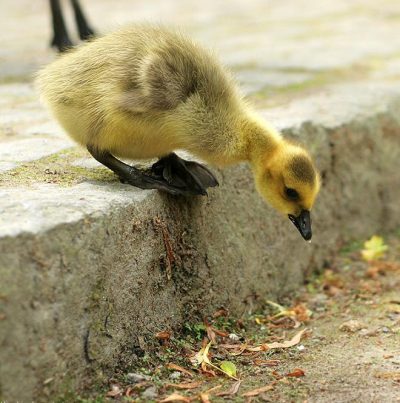
What exactly is a subatomic thought? Well, truth be known, I kind of made this up, but I based the idea on subatomic particles which are what comprise an atom: a subatomic particle is a particle that composes an atom.

This means that, in terms of thought, subatomic areas of thought comprise one’s thinking, and those areas determine one’s decision-making process.
Yikes! That’s a little bit heady. So let me attempt to frame this in simpler and practical terms that can be of more use to you.
The easiest way to illustrate how subatomic thought works is through the two primary areas of thinking, rational thought, and intuitive thought.
As I’ve stated in my book and in this blog series, in terms of genius thinking, one (rational thinking) we’ve made our dominant thinking style and the other (intuitive thinking) has become the secondary. Yet, according to Professor Albert Einstein, somewhere in our developmental process we’ve flipped the paradigm and have made rational thinking the predominant style and made what he deemed the more valuable thinking – intuition – the slave, or subdominant style of thinking.
What happens as a result is that when we think in terms of radical, groundbreaking, highly creative, or even genius-level ideas or concepts, on a whole, we tend to second-guess or doubt our thinking. In other words, we second-guess ourselves.
Why do we do this?
The simple answer is that we have these two styles of thought that are always in conflict.

The Two Selves
We all have two selves that are often in conflict with each other. These two selves have been mentioned again and again in literature and often used in books on self-improvement, such as Think and Grow Rich, Taming Your Gremlin, Psycho-Cybernetics, As Man Thinketh, Thought Vibration, The Master Mind, and The Lotus Sutra. They’ve been referred to as the angel and devil on your shoulder, your inner demon, the master and slave, that little voice…
In the realm of creating a powerful life of intention, it is not necessary to inhabit two selves within your consciousness. Yet people will argue that two selves are necessary because one is gentle and caring and the other strong and decisive. But this is not the case.
Conflict, in this way, inhibits growth! Harboring two selves causes you to second-guess, keeps your choices conflicted, and only one can surface at a time, just as two opposite emotions (happiness and sadness) cannot occupy your mind simultaneously. And because we are guided by our Belief Systems, many people defer to the weaker-self over the powerful-self, most of the time. However, your powerful–self is your true, natural self, trusting in his intuition completely, and lives life from a place of confidence, loving, and connected energy and passion. The weaker-self was created from the inner, conflicting struggle of your Belief System; always causing doubt and second-guessing your instincts and natural choices, thereby causing feelings of lack and scarcity; while simultaneously feeling the need to be validated or rescued. In fact, as long as you maintain the need for two selves you will always have inner conflict in your thinking, ideas, and their execution or implementation.
When we doubt or second-guess ourselves, we are really buying into the limiting Belief System that was instilled within us. Many will say their weaker-self has made them who they are today and that they are proud of that realization. However, who they are is not a result of the weaker-self.
Who we ultimately become, is the positive result of having worked painstakingly through hard, often difficult situations that previously blocked one’s progress. Struggle, and what we call failure, is the powerful-self’s ability and opportunity to learn to overcome, change, grow, and evolve.
It’s actually the weaker-self who is wanting to stay stuck in hardship, lack, and scarcity. The weaker-self created the phrase, “See, I knew it wouldn’t work out.”
This is not what makes you powerful! The power within love, high vibrational energy, connection to the world, focus, creativity, and passion are what makes you powerful; not some broken, scared part of you.
Your resolve to no longer remain in pain or failure is not because of anything your weaker-self provides, but, instead, it’s because your powerful, loving, connected self wants only the best for you. Shamanic practices teach us to tap into the power of our own goddess or god within in order to find our strength, courage, and conviction.
Counterintuitively, the weaker-self is not even remotely gentle and caring. In fact, it’s the complete opposite.
The weaker-self typically wants to be rescued and seeks someone to hold its hand and walk them to the finish line. It’s actually very selfish; always seeking validation and praise, needing everything to be handed to it based upon its perceived “goodness.” This is nothing more than weak and needy.
The powerful-self has also been misinterpreted.
Often thought to be demonstrative and controlling, it’s actually when one is in a state of real power that the stronger self gains the ability (and resources) to provide unlimited amounts of creative thought, the boldness of divergent thinking, the ability to experiment, explore, and seek out new adventures, and the confidence to trust in one’s objectives and ideas, even when others can neither see nor understand the path you’re traversing.
When you’re living in this powerful state of self you can fully access who you are, and no longer are you limited by overwhelm, fear, or doubt. The most interesting thing is that we’ve all – at one time or another – experienced this powerful-self. There have been times when you are firing on all pistons, hitting your stride, as if there is nothing you can’t handle.
When you’re in this euphoric state, you feel confident, connected to the world, happy, joyful, carefree… a little child-like, and bold in your ideas, thoughts, and attitude. In this state the traffic lights all hit green. The world seems brighter. Your creativity is ignited. You become more united, engaged, and present with everything and everyone you encounter.
You actually seek out bigger challenges and look for more exciting opportunities in everything you do.
Here are some tips to understand what you need in order to be at your most powerful level in your developmental process:
Ego – When ego is part of the mix one cannot fully be engaged to being more creative, take bigger risks, and to think divergently, simply because ego gets in the way. Another way to say this is that ego swims in the realm of not wanting to fail, and therefore, it resists taking the bigger challenges before you. Yet it’s within failure that we learn how to pivot to the best path toward success. Ego is needy and cares more about the opinion of others over doing something hard that can possibly lead to failure. Ego says, “Don’t take risk, don’t look foolish, don’t cause waves.”
Creativity cannot fully develop when ego is involved because ego will always choose to inhibit radical thought that can lead to revolutionary ideas. That ‘spark’ that imagination requires in order for one to make his own path is like kryptonite to ego. Children don’t think in terms of ego when making the choices and creative opportunities they choose. That’s why they can dress up in costumes just to go out to breakfast in public. Or to create a fantasy world of play and imagination in a simple, unassuming backyard. Imagination soars when it’s free. Ego clips its wings. Practice leaving your ego at home and see how much bolder you are in your choices, ideas, and pursuits.
Tribal Beliefs – By now, we know that tribal conditioning is the belief that we adopt into our lives through our role models, parents, siblings, neighbors, social groups, and communities, as well as both our religious and political affiliations. At some point in our development, we accept these beliefs as true without verifying if they are true or even necessary. In the past, I’ve given examples of beliefs society used to accept without question until they were later challenged: “Four out of five doctors recommend Camel cigarettes.”

If we question the source, question why we believe these ideas, if we dig deeper and investigate and challenge the merits of its existence, we can then replace them with more powerful beliefs that better serve our needs and thinking. Accepting something because that’s the way it has always been done, or because the ‘if it ain’t broke, don’t fix it’ mentality, is not the way to gain a genius mindset. We’ve been conditioned to accept a belief without challenge, and it may be time to take a deeper look into where your choices and decisions come from. Creating new beliefs based upon your own questioning, curious nature, and personal outlook on life is a much stronger way to develop yourself as a creative person.
Simplified Thinking – Dr. Wayne Dyer had an amusing saying. He said, “Always follow rule number 6. Rule number 6 is, ‘Don’t take yourself too seriously.’” And by the way, he also added that there are no rules 1-5. What I like about this is that it lets me off the hook, most of the time.
But if I could add to this, I would say that the simplest route is often the best. When we complicate our decisions, actions, and choices, we tend to create a sense of doubt, worry, and anxiety. Taking the simplest route often means taking a chance on yourself and just ‘going for it.’ And while some of those choices might turn out to be wrong, when you practice this, you are also building a framework for trusting in your intuitive self, and thereby gaining a boatload of confidence along the way.
Overthinking stifles our decisions and creates a barrier that inhibits us from taking the bigger risks, looking farther than we have in the past, and it causes us to limit our choices. When you keep things simple, not creating tons of choices or options (in case you are wrong), or not always thinking in terms of a ‘Plan B’, you free yourself up to do what’s in front of you, and to take a chance on yourself, right or wrong. The beauty is that you can always course correct as you go. Too many options can cause overwhelm.

You were given the right mindset from birth. Society, comparing yourself to others, adopting and indoctrinating the beliefs of others is what causes us to doubt, feel lack, and limit our choices. Be willing to fail, but don’t give up. Accept that your choices came from your brilliant, creative mind. Learn to enjoy and even laugh at your missteps along the way. Choose the simplest option, and just go for it! And if all that fails, do whatever a four-year old would do… Dress in silly, fun clothing, and go have coffee. Or… trust that you knew what was right all along.